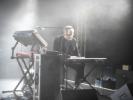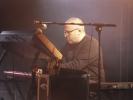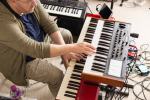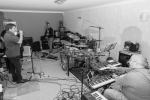"Keyboards and stuff... WARNING: This may be incomprehensible to people who actually have a life" - ReGenesis' Doug Melbourne gives TWR the lowdown on the preparations for the bands 2016 Lamb tour...
In October 2016 ReGenesis are touring the UK with a brand new production of The lamb Lies Down On Broadway. Visually this will be a new show owing very little to the original. In 2016 we can do things with computers and animation that were simply not around in 1974 so we have decided to go for a “new” look.
Musically though it’s a different matter. ReGenesis have always prided themselves on accuracy both in notes and chords but also in the sounds. , of the original. We play the songs authentically 100% live and nothing has changed in that respect!
A big part of that magical sound is delivered by Tony banks’ keyboards and getting those sounds is my job. If anyone is interested, I have written a book about the adventures of ReGenesis - “How Much Do We Get For This Gig Anyway?” available on the Amazon web site and an article in Sound On Sound regarding my keyboards. The band has existed for over two decades and during that time the way I have approached the gigs has changed due to wear and tear (on me as well as on the keyboards!) and improvements in technology.
I have changed every single component of my rig over the years but always with a view to recreating the sound of Tony Banks’ keyboard rigs from 1970-75. I’ve even done the gig with the original instruments which, rather strangely, sounded less authentic than some of my other rigs!
I left ReGenesis in 2002. At that point I was playing a heath Robinson rig with original instruments, samplers, digital synths, disk drives, MIDI and god knows what else! I am pretty sure that the TARDIS had a simpler interface!
When I returned to the fold in 2009, I adopted a principle of simplicity - three keyboards, no rack, mounted equipment, no MIDI and no effects. The rig I used in 2009 was:
A Nord Electro (organ and piano sounds).
A Kotg MS2000 (Lead synth sounds).
A Roland XP30 with expansion boards (Mellotrons, electric pianos and miscellaneous other bits and pieces). |
|
|
This was a good rig but for The Lamb.. I need a change. On The Lamb… and A Trick of The Tail, Banks uses a lot of pressure sensitive modulation - that is , holding down notes and increasing pressure on them to trigger various effects - vibrato, pitch bend, filter modulation etc. The best examples of this technique are probably on Riding The Scree, The Waiting Room (fine title that - AH) and the fabulous outro to Entangled.
The MS2000 unfortunately doesn’t do that, so I retired it to the keyboard rig in the sky (eBay) and replaced it with a Dave Smith Instruments Mopho SE. Dave Smith is my favourite instrument maker, and was responsible for the Prophet Five and Prophet Ten instruments so beloved of Tony banks in the Eighties. He also invented MIDI and the world’s first “soft synth” - a synth that operates on your computer with clever software.
The Mopho is a superb lead synth and has the appropriate modulation capabilities for The Lamb! After a lot of programming, I had a pretty close match for The Lamb’s various synth sounds originally created on the ARP Prosoloist. Close, but not identical…
However, unlike the MS2000, the Mopho doesn’t have built in effects such as echo, reverb etc. Echo/Delay was an important component of Tony banks’ sound, so I couldn’t manage without something. I would need an external effects unit. Was my simple rig under threat?
It was indeed. Another feature of The Lamb… is the amount of tuned percussion on it which makes an important contribution to the sound - we are talking about vibraphone, glockenspiel… that sort of thing. Although Nigel (Appleton) could play those sounds from an electronic drum pad added to his drum kit, some of the sounds would need to be triggered from my keyboard rig via a MIDI cable connecting the pad to my synths. After some discussion, I was clear that I needed another synth module (more of that later).
The simple keyboard rig was no more! Might as well be hung for a sheep as a… (drum roll) … lamb! Sorry! I added an Apple iPad running an Akai sampler to trigger a couple of noises - namely the big slides that occur during It. This worked well although I immediately started receiving death threats from people who believed that Apple is Satan and Steve Jobs’ was the Antichrist’s more evil brother.
Apple present a big problem to the IT industry - lets face it, if other gadgets worked as reliably as Apples’ then they would all be out of a job (adopts a disguise and changes name to avoid computer programmers chasing me around with burning torches and pitchforks). And I had changed my keyboard mixer from my old Mackie to an Alesis USB mixer which included some built in f/x that I could use with the Nord piano and organ sounds.
And then temptation beckoned when I got in touch with an old acquaintance, Joachim Verghese in Finland (our tour guide during TWR’s infamous visit to Helsinki in 1998 for the final CAS gig - AH). Joachim hand builds synthesisers for some reason and his latest creation was a module called a Prosoloist + - a digitally recreated set of ARP Prosoloist sounds including every single synth sound needed for The Lamb! This could be mounted in a case and connected via MIDI to my Mopho to trigger all the sounds!
My simple rig was no longer simple or basic. It now consisted of…
Nord Electro (Piano and Hammond Organ sounds).
Roland XP30 with “Vintage Synths” and “Keyboards of the ‘60’s and ‘70’s” expansion boards - (RMI piano and organ sounds, Mellotron strings, choir and flutes and miscellaneous bits).
DSI Mopho SE - basically a controller keyboard for Prosolosit + rack (all Prosoloist sounds).
Roland JV1010 (tuned percussion sounds)
Apple iPad running an Akai iMPC sampler (various sounds)
Behringer RX1602 mixer (The Alesis didn’t last very long because having embarked on building a rack, I thought hat I might as well add a mixer which would make the set up much easier).
Moog expression pedals.
Yamaha sustain pedals.
Boss SE50 f/x unit.
Moulinex “Mister Smoothie” blender (OK, I made that one up!)
Roland keyboard amp.
Phew!
I tried this out at rehearsal and it sounded OK but there was a very quiet but ominous hum and inexplicable intermittent buzz. Initially we thought it was the rehearsal room but no - it was lurking somewhere in the rig. A painful process of research narrowed it down to the two oldest components in the rack - the JV1010 synth unit and Boss SE50 which sat side by side in the rack. We ditched the JV1010 which we had been using for those percussion sounds. Nigel had found a way of achieving the sounds through his electronic pad, so having a long MIDI lead was no longer required. Hurrah! The Boss f/x unit I replaced with a brand new Alesis Microverb 4. Silent, clean but sadly constructed by clowns. More of that later…
Then my amplifier started playing up - bah! Courtesy of a friend (Jon Bickle) I was supplied with a new powered monitor speaker to use as a keyboard amp - 1200 watts! It was capable of vaporising small animals at distances of up to 100 feet.
The final test was at our first full band rehearsal in November 2014! And… success! No strange noises, plenty of volume and less leads! And then it all went wrong!
During the rehearsal I lost one channel on my Roland Synth. Never mind, in IT Crowd style, I turned it off and turned it on again and it carried on as if nothing had happened but when I set my keyboards up at home, the problem (and solution) recurred. And by Christmas day, he channel had basically failed - aaarggh!
Initially I was annoyed and I mooched about the house muttering about how they didn’t build things to last anymore and then it occurred to me that I had had the Roland XP30 for nearly twenty years of constant use, countless gigs, countless times of being chucked in and out of the tour van. So maybe they had built it to last after all!
However, it could not have happened at a worse time. The problem with Roland failing was that there were sounds on it that I had gradually programmed and tweaked for ReGenesis going back over decades. So I could… carry on but use it in mono and hope that nothing else went wrong or… get it fixed at considerable cost and hope that nothing else went wrong. Or… get a new keyboard and then programme it from scratch.
A very kind friend of the band offered to look at the XP30 so we spent a merry morning looking at it. But while the general area it was going wrong in could be identified, the actual FAULT couldn’t no synth repair team would touch it. So it was dead, RIP. |
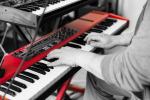 The Nord Electro
The Nord Electro |
It had been a long time since I considered an alternative to the Roland. The XP30 is what is known as an “S +S Synth” - Sample and Synthesis. it’s the form of synthesis that started way back when with the Korg M1 and Roland D50. Basically, instrument comes with a set of “waveforms” - some similar to those on a traditional synth but unlike a traditional synth which has perhaps three or four basic waveforms (triangle, saw tooth and square wave being the most common) these synths come with literally hundreds of waveforms, many of which are actually sampled “real” sounds, but less flexibility in terms of what you can do with them. You can combine these waveforms and filter and process them to make your own unique combinations.
In addition (way back in the 1990’s) there were empty slots in he keyboards for you to add expansion boards - date cards with new waveforms on. I had been using two of these expansion boards with ReGenesis - “Keyboards of the ‘60;s and ‘70’s” and “Vintage Synths”. they supplied me with the Mellotron sounds and the much harder to find RMI piano sound - that thin harpsichord like sound so prevalent on The Lamb… and Seconds Out.
Bu of course, no keyboard would take these expansion boards now. Which means I was missing the RMI sounds and Mellotron which make up approximately 50% of all the sounds you will hear on The Lamb…!Aaaargggh again!
Hasty research began. Although the XP and JV synths were no longer made, and as predicted, there were no modern instruments using the expansion cards, Roland had very obligingly taken all of the waveforms from their old cards and put them in a free, downloadable library - not only including all the old waves I needed but new improved Mellotron samples! Hurrah! Now I just needed a synth capable of loading these waveforms up for use in programming.
Given my fairly narrow requirements, it turned out there was only one synth on the market that fit the bill - a Roland FA-06. This was in some ways a descendant of the XP range but was a “Workstation” synth. In addition to being able to programme sounds and play them, it came with a sequencer which allowed you to write songs and effectively record them, and a basic sampler as well!
Of course, this type of instrument has changed massively in the last twenty years. It has literally THOUSANDS of sounds, THOUSANDS of waveforms and a pretty much endlessly expandable memory! All for about seven hudred quid. I’m guessing that an instrument of this scope in the Nineties would have cost several thousands, even if they could make such a thing.
Most importantly I could download waveforms from the Roland Sound Library, including all the old Mellotron/RMI sounds I needed. I just put in my order just before Christmas!
The festive season then became rather frantic as I tried to programme on a new synth with a COMPLETELY different interface and considerably different sonic architecture, all of the sounds I had built up over a couple of decades and needed for The Lamb… I had two days of frustration as I tried to programme it and store sounds in an identical manner to my old beloved XP. But while the FA-06 did have the guts of the old JV/XP systems buried in its menus, there was plenty of stuff I could no longer do.
The frustration ended whn I realised that I had to completely rethink how I put sounds together, how I stored them and how I changed from one to another during performance. Once I understood that and started to find my way around the excellent menu-driven interface, with its bright hi def colour screen, the sounds started coming.
At this point I was starting to feel excited - the Mellotron choir, strings and flutes were noticeably superior to the old samples and the RMI sounds were pretty easy to replicate. And using the new system I was able to create similar layers of sounds to hose I had on the old XP.
Another benefit was the built in sampler - this allowed me to ditch the iPad and trigger samples from the FA-06. Less gear, Hurrah! The sampler also facilitated some amusing possibilities for The Waiting Room … where’s that CD of Invisible Touch…
In the new year we rehearsed like crazy and then did two warm up gigs at the Half Moon in Putney and the Robin 2 in Bilston. The keyboard rig rocked! We had some prestigious guest in the form of Nick Magnus, Richard MacPhail and Nick Davies! They werelal very complimentary indeed. Both Richard and Nick wrote reviews which are on our web site : www.regenesis-band.co.uk/
Unfortunately the Alesis micro verb stopped working properly at the Half Moon although it made it through the gigs so more changes were made. Anyway, my eventual rig for our autumn gigs will be….
Roland FA-06 (Mellotrons, electric pianos, bass, samples).
Nord Electro (the only survivor of my old rig! Organs and piano).
DSI Mopho SE triggering… A rack mounted ARP Prosoloist + lead synth
Behringer rack mounted keyboard mixer.
Lexicon rack mounted effects unit (beautiful - listen out for it on The Lamia!)
Plus pedals, amps etc… |
|
I think I can say without prejudice, that it is by far he best sounding rig that I have ever used in ReGenesis and despite a bit more wiring, some and some outboard racks, it is still pretty light in weight and simple to set up. I am very happy.
So, what’s it like to play The Lamb…?
I love playing it. In order to get through it without too many mistakes took a GREAT deal of time, but is practice that pays off because once you have mastered a number of technical challenges, it becomes a joy to play. A hundred minutes to lose yourself in. To me it is like a hundred minute version of Supper’s Ready, even to the point of having a tricky 9/8 section near the end!
There are a number of technical challenges but I have practiced them to the point where I don’t notice them for the most part. The exceptions are Riding The Scree and The Colony Of Slippermen which, however much you practice, are hard to play. On a good day though, I can get through them without any errors.
My actual favourites, from a playing point of view, are the opening sequence of Lamb/Fly Broaday Melody/Hairless Heart, the Lamia and Colony Of The Slippermen. I am really looking forward to the autumn shows and hope to see some of you there! |
|
Doug Melbourne.
Thanks for sharing that fascinating behind the scenes look at what it takes to put a show like this together for us, Doug. See you in the autumn!
